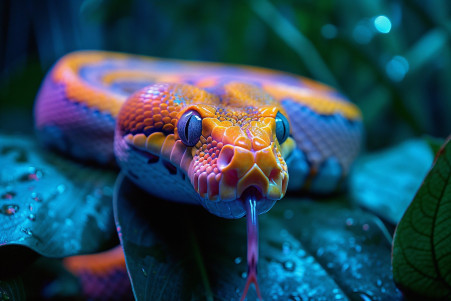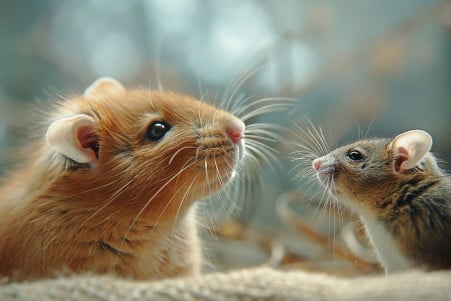Do Rats Come Out at Night? A Look at Rodent Nocturnal Behavior
22 February 2024 • Updated 21 February 2024

As the sun sets, you may find yourself wondering about the nighttime habits of the mysterious rat. And you’d be right to wonder since rats are mostly nocturnal. Rats have evolved to forage, socialize, and move around at night, which is when they are the safest from predators. While domesticated rats can adjust to their owners’ schedules, they are still nocturnal animals and are most active during the hours of dusk and evening.
Below, we’ll take a closer look at the fascinating world of rat behavior, drawing on research in the fields of zoology, environmental science, and animal psychology. We’ll cover everything from studies on rats’ nocturnal behavior to their physical changes in response to darkness to their circadian rhythms. After reading this overview, you’ll have a well-rounded view of what makes rats creatures of the night.
Are rats nocturnal?
The Role of the Environment in Rat Nocturnality
Environmental factors like photoperiod, temperature, and precipitation play a significant role in the development of rat nocturnality. A review in PMC explains that photoperiods, which change with latitude and season, have a strong impact on melatonin secretion by the pineal gland, which in turn affects the reproductive cycles and behaviors of rodents, including their nocturnal activity.
Meanwhile, an article in Scientific Reports suggests that rats have evolved to be nocturnal as a way to avoid environmental stressors, with the structure of their habitats being influenced by temperature and predation.
The process of urbanization has further shaped rat nocturnal behavior, with rats adapting their behavior in response to the changes in their environment.
An article in the Journal of Urban Ecology notes that human activities and urban landscapes change the availability of resources and the structure of habitats, forcing rats to modify their natural nocturnal behavior. For example, in urban areas, rats may change their activity patterns due to the presence of artificial light and human activity.
Research in a variety of environments has shown that while rats are naturally nocturnal, they can change their activity patterns in response to their environment. This flexibility helps ensure their survival and demonstrates the adaptability of rat behavior in response to environmental factors. This adaptability is important to consider as we learn more about the inner workings of rat circadian rhythms and how they are influenced by the environment.
The Secret Life of Rats at Night: Circadian Rhythms
Circadian rhythms are internal biological clocks that help coordinate the behavior of living things so that it happens at the right time of day. In rats, circadian rhythms help determine when they will be most active at night, ensuring that they are awake when they can find food and other resources and that they are asleep when they are most vulnerable.
A study published in PMC by Dr. Paul Franken discusses the development of circadian sleep regulation in rats, showing that distinct 24-hour rhythms of sleep and wakefulness are established by the third week of life.
However, circadian rhythms are also known to be disrupted by artificial light at night (ALAN).
A study published in Frontiers in Physiology found that even low levels of artificial light at night (ALAN) can disrupt the daily behavioral and metabolic rhythms of rats, leading to changes in their glucose and lipid metabolism. A study published in PMC by Randy J. Nelson demonstrates that these disruptions can have a wide range of physiological effects, impacting everything from rats’ sleep-wake cycles to their hormones.
Appreciating the importance of circadian rhythms in rats isn’t just about understanding their nighttime habits. It’s about understanding the delicate balance of their biological systems, which, when thrown off by artificial light, can lead to significant changes in their well-being and functioning.
This is important to keep in mind as we think about the ways rats are able to move around at night, considering both their senses and the physiological systems that help them survive and thrive.
Sensory Adaptations of Nocturnal Rats
Nocturnal animals must have highly specialized senses to survive in their environment, and rats have evolved to be especially well-adapted to life in the dark. Their sense of hearing is especially acute, and they also have an excellent sense of smell, which helps them find food and avoid predators.
As a study in PMC shows, the rat’s sensory cortex is neuroanatomically organized to support its nocturnal lifestyle, with a greater proportion of the cortex dedicated to somatosensory and auditory processing than in diurnal animals like squirrels.
Even the way rats see in the dark has been misunderstood. As a study in PMC shows, the idea that rats are blind to red light is a myth. Instead, rats are sensitive to far-red light, which means they can see better in low-light conditions than was previously believed.
Rat physiology has been affected by domestication, and as a review in eLife explains, laboratory rats still have many of the sensory adaptations of their wild ancestors, even if they may have some differences in their nocturnal behavior. As these studies show, rats’ senses are exquisitely adapted to help them survive in the dark. This not only ensures their own survival but also helps them play important ecological roles in their nocturnal environment.
The Night Shift: Rats’ Nocturnal Behavior and Impact on the Environment
Rats’ nocturnal behavior isn’t just a matter of preference; it’s an adaptive strategy that allows them to avoid predators and other threats. During the night, rats are constantly on the lookout for predators and use a variety of behaviors to stay safe, including responding to kairomones, which are odors produced by other animals that rats can detect and use to protect themselves.
A study in the Proceedings of the National Academy of Sciences even showed that rats have an innate ability to detect and avoid kairomones from predators like carnivores, which is important for their survival.
In addition to helping rats avoid threats, their nocturnal behavior also has important ecological consequences. According to the San Diego Zoo Wildlife Alliance, keystone species like the Stephens’ and San Bernardino kangaroo rats are important for seed dispersal and soil aeration through their burrowing, which can have a big impact on plant growth and the health of an ecosystem.
Yet, the impact of artificial light on rat foraging is a concern for researchers, who have found that rats’ activity patterns are influenced by the moon’s phases, suggesting that more research is needed.
The behaviors and contributions of rats in their natural habitats show how important it is to understand rats’ nocturnal behavior. This knowledge has important implications for the conservation of important rat species and for the development of pest management strategies in urban areas that take rats’ nocturnal behavior into account.
Urbanization and Rat Nocturnal Behavior
Rat nocturnal behavior has been significantly impacted by urbanization. One paper in the Journal of Urban Ecology even suggests that urbanization increases the risk of rodent-borne diseases by increasing the frequency of interactions between rats, humans, and other animals. As human urbanization increases, rat populations are forced to adapt, and urban rats often adjust their nocturnal behavior based on the availability of resources and human activity.
The relationship between rats and the urban environments they inhabit is complex. A study in the Proceedings of the National Academy of Sciences notes that increased urbanization changes rat activity patterns, potentially increasing the risk of zoonotic diseases. In particular, urban light pollution has been shown to disrupt rat circadian rhythms, which can impact their health and behavior.
In light of these studies, it’s important to develop urban pest control methods that consider the nocturnal behavior of rats. By recognizing and working with the ways rats have adapted to urbanization, we can develop control methods that are more successful and humane, reducing the risk of zoonotic diseases and improving the relationship between urban rats and the humans they live among.
What We’ve Learned About Rat Nocturnality
In our foray into the world of rat nocturnality, we have learned that rats are not just casual night owls but have a deep evolutionary connection to the night. From the environmental factors that influence their nocturnal behavior to the circadian rhythms that govern their nightly lives, rats are incredibly adaptable.
The research into rat nocturnality has implications beyond academia, especially in the realms of pest control and ecology. By understanding the behaviors and physiological changes that have enabled rats to become such successful nocturnal animals, we can better manage urban rat populations and the health risks they pose.
It’s clear that nocturnality has helped rats thrive. As our urban environments continue to expand, more research is needed to fill in the gaps in our knowledge of nocturnality and its relationship to urban environments. Going forward, we need to appreciate the complexity of rat nocturnality and learn to live with these adaptable nocturnal creatures.


